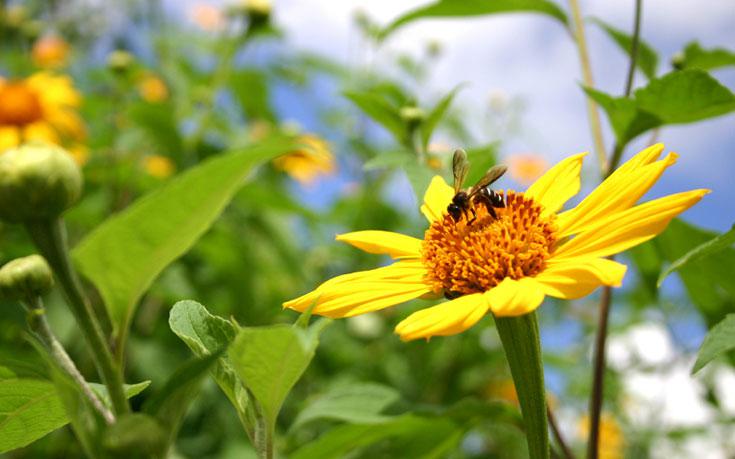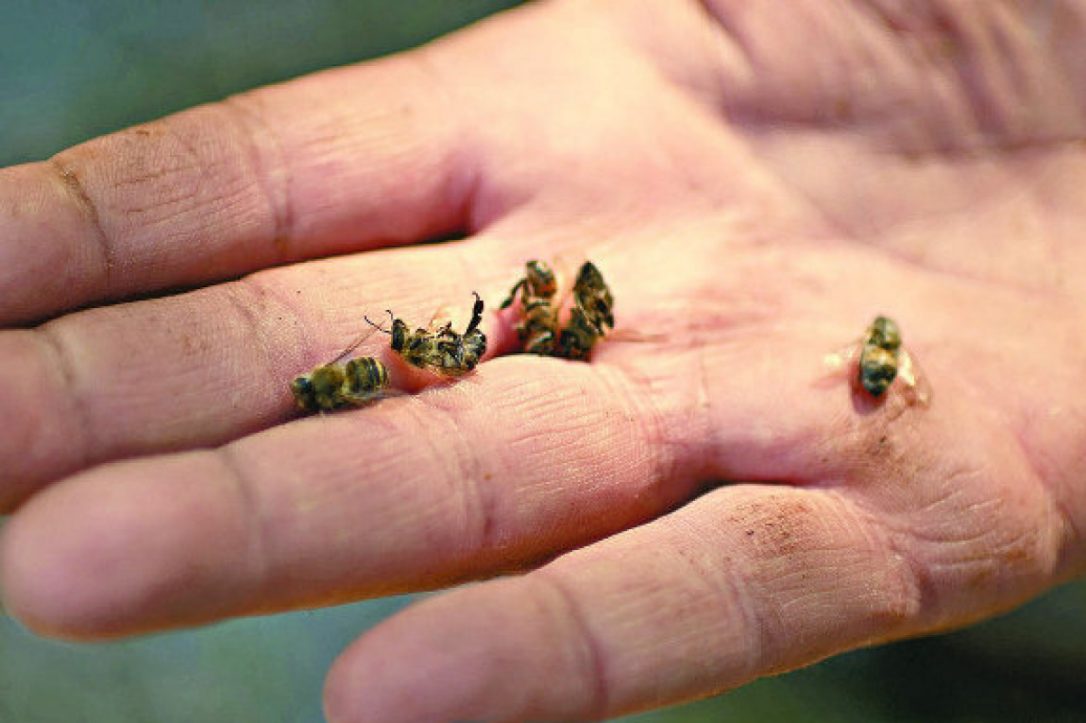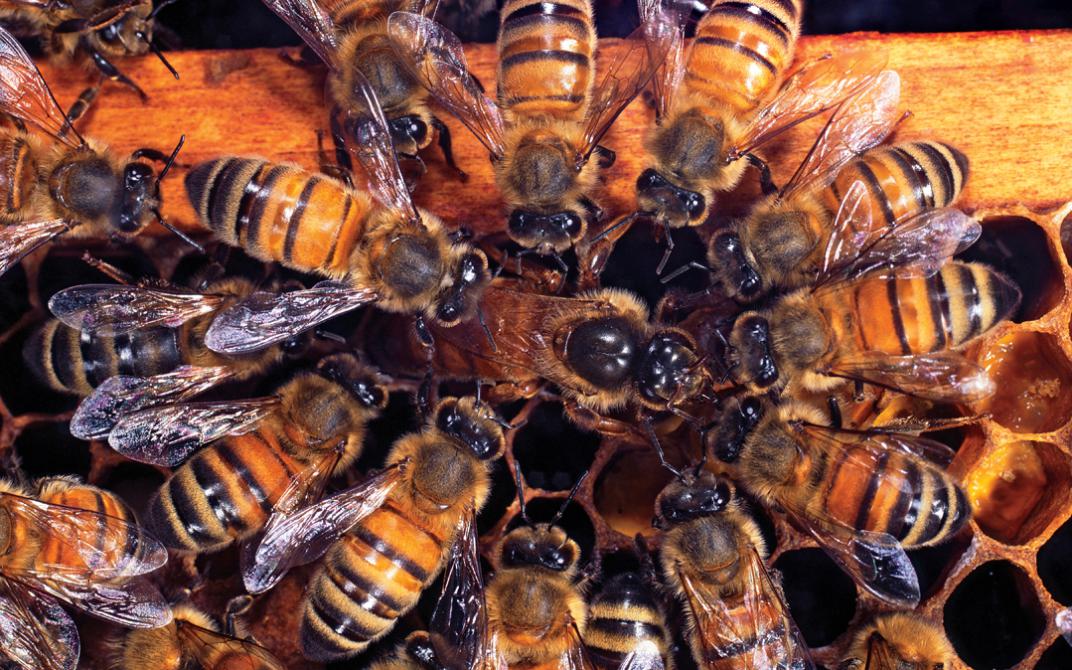By Neil Carman

A new environmental challenge heating up over the last decade is the rapid decline of honeybees. Colony Collapse Disorder - or CCD - is being reported worldwide. The key suspect is a new group of pesticides – nicotine-like substances called “neonicotinoids,” or neonics for short. Neonics are estimated to be 1,000 times more toxic than DDT, according to French scientist Jean-Marc Bonmatin. Neonics are similar in structure to the natural compound nicotine, but the neonics are synthetic-based chemicals made from petroleum like most pesticides used in industrial agriculture.
CCD is important because honeybees are critical in food production and the yearly losses of commercial bee hives continues to be serious. Food production needs honeybees since pollinators make possible an astounding 35% of global food production by fertilizing flowers of several dozen species of fruits, nuts, and vegetable crops. According to the U.S. Department of Agriculture (USDA), honeybees add $24 billion to the U.S. economy. Commercial beekeepers have been struggling in the U.S. to keep their hives healthy as CCD takes a rising toll, and some beekeepers have recently shut down due to devastating honeybee losses that are too costly to replenish.
Plummeting populations
According to two stunning new reports, the collapse of honeybee populations is worse than we ever thought. In its first-ever U.S. honeybee health survey, USDA found that commercial honeybee populations fell 8.1 percent in 2015 on top of years of decline [1]. Likewise, researchers in another study found that, among all beekeepers, 44 percent of bees were lost nationwide from 2015 to 2016 [2]. The USDA blames bee losses on a combination of parasites, viruses, lack of food sources, loss of bee habitat, and, of course, the new neonic pesticides. In addition to showing the critical loss of honeybee populations, this research also suggests that bee-killing neonic pesticides are one culprit of colony collapse [3]. But the number of managed honeybee colonies in the U.S. has declined from six million in the 1940s to just 2.5 million today – jeopardizing our food supply and domestic agriculture industry [4].
 This isn’t the first time the federal government has admitted pesticides are a leading contributor to bee colony collapse. Last year, a similar survey, funded in part by the USDA’s National Institute of Food and Agriculture, revealed that U.S. beekeepers lost over 42% of their colonies between April 2014 and April 2015, a significant upswing of losses from the previous year [5, 6]. The USDA and the Environmental Protection Agency (EPA) have hesitated to blame the CCD problem solely on neonic pesticides, or conclude that the chemicals have broader ecological impacts. But the USDA’s and EPA’s limited views are slowly evolving, because scientists have been discovering that the environmental impacts of the new neonic pesticides appear to extend beyond the pollinators, as ripples are being documented in other insect, butterfly, and even bird species.
This isn’t the first time the federal government has admitted pesticides are a leading contributor to bee colony collapse. Last year, a similar survey, funded in part by the USDA’s National Institute of Food and Agriculture, revealed that U.S. beekeepers lost over 42% of their colonies between April 2014 and April 2015, a significant upswing of losses from the previous year [5, 6]. The USDA and the Environmental Protection Agency (EPA) have hesitated to blame the CCD problem solely on neonic pesticides, or conclude that the chemicals have broader ecological impacts. But the USDA’s and EPA’s limited views are slowly evolving, because scientists have been discovering that the environmental impacts of the new neonic pesticides appear to extend beyond the pollinators, as ripples are being documented in other insect, butterfly, and even bird species.
Who is fighting this?
In my volunteer role on the Sierra Club’s national Genetic Engineering team and its Pollinator Protection subgroup, I was asked by Center for Food Safety (CFS) attorneys about Sierra Club’s interest in the bee-pesticide issue and a potential legal case. Due to the serious concerns about bees being poisoned by the neonics, although no state or national Sierra Club staff are paid full-time to work on the CCD issue, I coordinated efforts for the Sierra Club to approve participation in the suit in 2013.
A CFS legal team is handling the suit for beekeepers, CFS, Sierra Club, Beyond Pesticides, Pesticide Action Network North America, and Center for Environmental Health in the first neonics case of its kind against the EPA. The suit alleges that the EPA violated the Federal Insecticide, Fungicide and Rodenticide Act (FIFRA), the Endangered Species Act, and other laws.
CFS filed the bee protection suit on March 21, 2013, against the EPA Pesticide Division over 15-year “conditional approvals” that lacked evidence of safety, and yet the EPA issued these approvals to large agro-chemical firms – Bayer CropScience and Swiss-based Syngenta – to sell harmful neonic pesticides. The only pesticides named in the suit are neonics that are being widely used in seed coatings to prevent insect damage during planting and germination.
How do the bees encounter neonics?
A major problem is that EPA has not been properly regulating pesticides used in seed coatings like pesticides sprayed on crops, and granted the allegedly illegal approvals using a regulatory loophole. A serious biological problem is that sprouting seeds absorb the neonics from the outer coating and transport them up into the flower, including pollen and nectar that are collected by bees. Neonics are also exuded in small water droplets on the plant’s surfaces that bees drink from, while other neonic residues are released into the soil and groundwater with ecological implications. Honeybees can fly a few miles searching for food and are exposed to neonics through pollen, nectar, and exuded water. Bees’ sensitive flight navigation system can become disrupted and then the bees are too disoriented to fly back to the hive. If the bees do make it back to the hive, the entire beehive may suffer pesticide exposures as the contaminated food is used in brood production and feeding the queens.
Neonics were designed to target insect nervous systems since they interfere with neurotransmitters. New evidence strongly points to serious unintended effects on honeybees and bumblebees, which the EPA did not adequately account for during its conditional approvals. The two neonics listed in the suit are thiamethoxam and clothianidin, although imidacloprid is another neonic approved the same way by the EPA. Clothianidin and its parent compound, thiamethoxam, are two widely-used pesticides, which have been shown to adversely impact the survival, growth, and health of honeybees and other pollinators. Sierra Club’s G.E. team actually sent the EPA two letters in 2008-09 asking that these neonics be banned until their safety had been proven, but the EPA wanted more time to study the problem until 2017.
The lawsuit states: “In a vast and extremely risky experiment, the EPA has allowed over two million pounds of clothianidin and thiamethoxam to be used annually on more than 100 million acres and on dozens of different crop plants without adhering to existing procedural frameworks and with no adequate risk assessment in place.”
Beyond the bees
Pesticides like neonics harm many more creatures than just honey bees. In March 2013, the American Bird Conservancy published a commentary on 200 studies of neonics and called for the EPA to issue a ban on their use as seed treatments because of their toxicity to birds, aquatic invertebrates, and other wildlife. Thiamethoxam is one of the most deadly pesticides for honeybees. Even at a very low dose – less than one part per billion – results in honeybees being acutely intoxicated. Thiamethoxam damages bees ability to fly and to navigate; their ability to reproduce is impaired and their ability to forage is reduced. Bees affected by neonicotinoids are also more vulnerable to disease and parasites. This is confirmed by the Greenpeace study, "Bye, bye bee? Bee Deaths and the risks for Agriculture in Europe."
A recent study from the Netherlands reveals, for the first time, that neonics are also to blame for the decline of farmland and meadow bird species. Evidence against the neonics appeared in the July 2014 issue of the leading science journal Nature citing a study based on an observed correlation between declines in some bird populations and the use of neonics in the Netherlands. The study demonstrated the levels of neonics measured in environmental samples correlated strongly with the decline in populations of insect-eating birds.

An editorial published in the same Nature edition found that the possible link between neonics use and a decline in bird numbers is “worrying” pointing out that the persistence of the compounds (half-life of 1,000 days) and the low direct toxicity to birds themselves implies that the depletion of the birds' food source (insects) is likely responsible for the decline in bird numbers and that the compounds are distributed widely in the environment. The Nature editors write that while correlation is not the same as causation, “the authors of the study also rule out confounding effects from other land-use changes or pre-existing trends in bird declines.”
Neonics are posing significant new ecological threats. Wherever these pesticides are used, the birds are disappearing, according to researchers from the University of Radbound in the Netherlands. The reason is that neonics are water soluble and are washed out of fields to kill invertebrates living in ponds, streams and ditches - as well as the larvae of insects which are food for birds and their chicks.
Action Elsewhere
On July 27, 2016 the German Ministry of Agriculture banned the use of neonicotinoids (clothianidin, imidacloprid or thiamethoxam) as seed-coatings for winter crops, all over Germany to protect bees. Seeds treated with these insecticides were already banned within Germany, but under the new regulation any neonicotinoid seeds which are imported from other countries are prohibited as well.
Action Here!
The EPA is currently reviewing the effects of neonics on pollinator colonies. With this new data proving honeybees are on the brink of widespread collapse, we must act now to urge the EPA to ban these toxic pesticides once and for all.
In places like China where there is a lack of pollinators, workers go flower to flower shaking pollen in order to pollinate fruit trees. You can help prevent a similar situation here at home by planting flowering plants to support local beehives and by checking to make sure that the plants you buy at nearby nurseries have not already been treated with dangerous neonics.
You can also sign this petition to encourage True Value and Ace Hardware to stop selling bee killing pesticides. Home Depot has already vowed to do so. Take these steps and tell your friends so that we may continue to enjoy the work of the honeybee and all of the other insects and birds affected by these debilitating pesticides.
References
1. “Honey Bee Colonies,” U.S. Department of Agriculture, May 12, 2016
2. “Nation’s Beekeepers Lost 44 Percent of Bees in 2015-16,” Bee Informed Partnership, May 10, 2016
3. Alan Bjerga, “U.S. Bee Colonies Continue to Decline as Pests, Chemicals Blamed,” Bloomberg, May 13, 2016
4. "Fact Sheet: The Economic Challenge Posed by Declining Pollinator Populations," The White House, June 20, 2014
5. “Colony Loss 2014-2015: Preliminary Results,” Bee Informed Partnership, May 13, 2015
6. Nicola Seitz, et al., "A national survey of managed honey bee 2014–2015 annual colony losses in the USA,” Journal of Apicultural Research, May 20, 2016